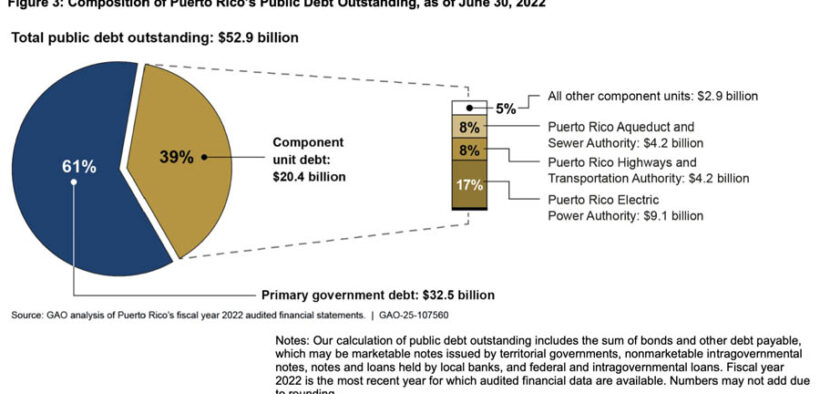GAO finds $1.9B Puerto Rico surplus, warns of unresolved PREPA debt

Puerto Rico reported a $1.9 billion surplus for fiscal year 2022, marking a shift from two consecutive years of deficits, according to the U.S. Government Accountability Office’s (GAO) latest review of public debt in U.S. territories.
The GAO noted signs of economic and fiscal progress but warned of unresolved risks, particularly related to the Puerto Rico Electric Power Authority’s (PREPA) debt.
As of June 30, 2022, Puerto Rico’s total public debt stood at $52.8 billion, or 47% of its gross domestic product (GDP) and 67% of its gross national product (GNP). Since the passage of the Puerto Rico Oversight, Management and Economic Stability Act (Promesa) in 2016, the commonwealth has restructured $64.7 billion in debt, reducing obligations by $36.5 billion. PREPA’s $8.5 billion debt remains unsettled.
PREPA’s pension fund was depleted in December 2024, requiring $375 million in loans from the central government to maintain monthly payments. “As of May 2025, the primary government has provided PREPA with $375 million in loans, which will cover PREPA’s pension payments through June 2025,” the report said. The Financial Oversight and Management Board has recommended rate increases to sustain funding.
The electric grid continues to face outages and high prices. In January 2025, Puerto Rico’s electricity averaged 29 cents per kilowatt-hour — about 80% higher than the U.S. mainland average. The GAO reported that Puerto Rico residents experience more frequent power losses than any U.S. state.
Puerto Rico’s economy showed modest growth, with a GDP of $125.8 billion and GNP of $85.6 billion in fiscal year 2024. The GAO reported that between fiscal years 2021 and 2022, real GDP grew 3% and real GNP grew 2%, attributing much of that growth to post-disaster federal assistance.
“According to government officials, the influx of federal funds provided to mitigate the effects of hurricanes Irma and Maria in 2017 and of the COVID-19 pandemic contributed to Puerto Rico’s economic growth,” the report noted.
Despite these gains, the Economic Activity Index fell each month from September 2024 through February 2025 compared to the previous year.
The GAO also cited population decline as a risk. Puerto Rico’s population decreased by 12% between 2010 and 2020 and stood at 3.2 million in 2024. Officials acknowledged that ongoing migration could reduce the tax base and economic activity.
Long-term liabilities remain substantial. Pension and post-employment obligations totaled $57 billion in fiscal 2022, about 50% of GDP. The pension reserve trust created in 2022 has received $3.4 billion in contributions and may begin withdrawals in fiscal 2032 if conditions are met.
A 2022 debt management policy caps annual debt service and limits new tax-supported debt to refinancing and capital projects. The GAO confirmed that no new tax-supported debt unrelated to restructuring has been issued since.
Component units showed improved finances, with fiscal 2022 revenue rising 23% to $11.1 billion, driven largely by electricity charges passed on to customers by PREPA.
However, the island still faces issues with timely reporting and recurring audit findings. Fiscal 2022 audited statements were released 22 months late. The Department of Labor and Human Resources lacked proper accounting controls, and the Department of Education failed to detect duplicate payroll payments, the GAO noted.
While financial indicators have improved, the report concluded that unresolved energy, demographic, and governance challenges continue to pose threats to long-term stability.
“Improving the reliability and cost of Puerto Rico’s electricity is critical to attract and retain business and to support sustained economic growth,” the GAO stated.












